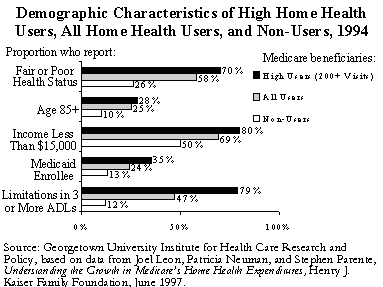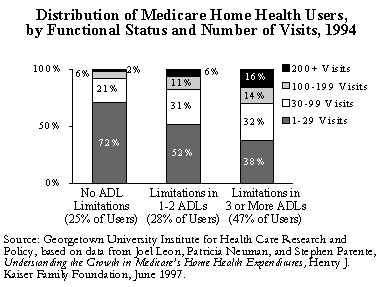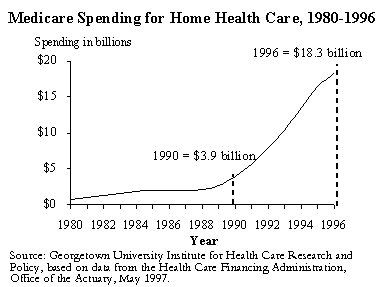The home health benefit has been one of the fastest-growing components of the Medicare program over the past decade. As spending for home health services has spiraled upward, the benefit has become a focal point in efforts to reduce overall Medicare spending. The Balanced Budget Act (BBA) of 1997 sought to control this growth by changing Medicare's method of paying for home health services.
Users of home health services are among the sickest of Medicare beneficiaries. For those with a chronic illness or disability who have both acute and long-term care needs, the benefit fills an important gap in coverage. These high users will likely be the most affected by the new measures.
WHAT IS THE MEDICARE HOME HEALTH BENEFIT?
Home health care is one of Medicare's "post-acute care" benefits, which provide skilled services and therapies for patients who do not need the more intensive level of care offered in hospitals. Specifically, the benefit covers intermittent skilled nursing care, home health aide services, medical social services, and physical, speech, and occupational therapy for homebound patients. Medicare places no limits on the number of visits a patient can receive, and beneficiaries pay no deductibles and make no copayments.
In 1996, about 10 percent of the 38 million Medicare beneficiaries used home health care. Most users receive few visits; in 1994, 51 percent had fewer than 30 visits and 23 percent had fewer than 10 visits. Ten percent of users, however, received 200 or more visits during the year.
Compared with other Medicare beneficiaries, the highest users of home care—those with 200 or more visits per year—are more likely to be at least 85 years old, in fair or poor health, enrolled in Medicaid, and have low incomes.
Among high users, almost four of five (79 percent) report needing personal assistance with three or more activities of daily living (ADLs)—bathing, getting in and out of a bed or chair, using the toilet, dressing, eating, and walking. In addition, most also have multiple medical needs that demand a range of acute and long-term care services. Relative to those users who require shorter episodes of care, high users receive more visits from home health aides and fewer from skilled nurses.

Having long-term care needs, however, is not always associated with high use of home health services. In 1994, only 16 percent of users with limitations in three or more ADLs had 200 or more visits, and nearly four of ten (38 percent) had fewer than 30 visits.

WHY HAS SPENDING ON HOME HEALTH CARE GROWN?
Medicare is the largest payer for home health care, financing an estimated 40 percent in 1995. Medicare expenditures for home care rose from $3.9 billion in 1990 to $18.3 billion in 1996—an annual growth rate of 29 percent, nearly three times the 11 percent rate for total Medicare spending. Home health care accounted for 3.6 percent of total spending in 1990 and 9.2 percent in 1996.
An increase in the number of visits per user accounted for half (49 percent) of the spending growth. From 1990 to 1996, the average number of visits per patient more than doubled, from 36 to 77. The share of users with 200 or more visits rose 4 to 10 percent annually from 1991 to 1994. More than a third of the growth (36 percent) is attributable to an increasing proportion of beneficiaries using home services. Growth in average payment per visit and enrollment in Medicare accounted for 8 percent and 7 percent, respectively, of spending growth.

Increases in spending for the highest users have been particularly dramatic: Their share of total home health expenditures grew from 20 percent in 1991 to 43 percent in 1994.
Among the explanations for the rising number of home health visits and proportion of beneficiaries using home services are the expansion of criteria for eligibility and coverage and the loosening of regulatory oversight in 1989. Other contributing factors include cost-based reimbursement, growth in the number of proprietary home health agencies, declines in hospital stays because of Medicare's prospective payments for inpatient hospital services, and advances in medical technology, which have allowed some patients to be treated at home.
HOW DID THE BBA AFFECT HOME HEALTH POLICY?
In an effort to control home health costs and limit the volume of services, the BBA made a number of changes to Medicare's home health policy, particularly with regard to its payment structure.
Home health agencies will continue to be reimbursed on the basis of costs until October 1, 1999, but they will be subject to new and tighter limits. Payments will be constrained based on the lower of two limits: a modified cost limit on the agency's total reimbursable costs, or a new per-beneficiary limit.
On October 1, 1999, this interim payment system will be replaced with a prospective payment system (PPS) for home health services under which Medicare will pay a predetermined amount per unit of service. The BBA requires the Department of Health and Human Services to develop a PPS that will produce 15 percent in savings, relative to the previous year's spending, in fiscal year 2000. If the PPS is not ready to be implemented on that date, the cost and per-beneficiary limits are to be reduced by 15 percent instead.
The specific details of the new system—such as the unit of service for the prospective rates and a patient classification system—will be developed over the next two years. Payment rates are to account for differences in patients' needs and geographic variation in wage levels.
Other BBA provisions that will affect the delivery of home health care include:
- narrower criteria for determining the need for skilled nursing care, which will likely restrict eligibility and coverage for home health;
- new authority for the Department of Health and Human Services to set standards on the frequency and duration of home health services; and
- changes in hospital payments that may reduce the financial advantage for hospitals of discharging certain types of patients to home health after relatively short stays.
The Congressional Budget Office projects that the BBA provisions will lower Medicare home health spending by $16.2 billion, or 12.8 percent, over a five-year period. From fiscal years 1998 through 2002, spending is expected to grow 5.8 percent annually, with expenditures rising from $19.0 billion to $25.2 billion. Pre-BBA projections had estimated 9.5 percent annual growth for the period.
HOW WILL CHANGES AFFECT HOME HEALTH USERS?
BBA provisions related to home health are intended to slow the growth rate of costs and improve providers' incentives to deliver care more efficiently. However, if Medicare payments do not adequately reflect costs, both the interim system and the PPS may restrict access to care, especially for high users. Developing payment adjustment methods that adequately reflect variation in patient characteristics is essential for preserving quality of care. In addition, careful monitoring and oversight will be necessary to safeguard beneficiaries' access to home health care as the new payment system is implemented.